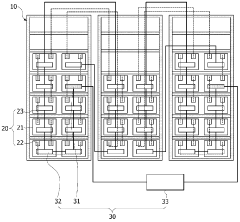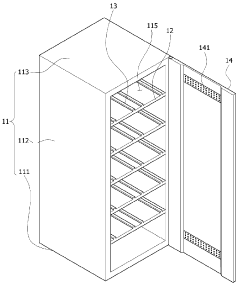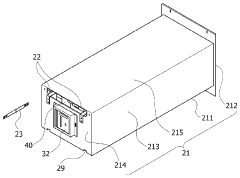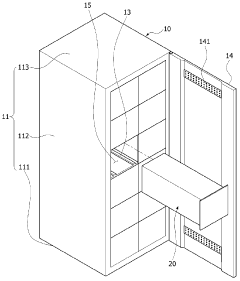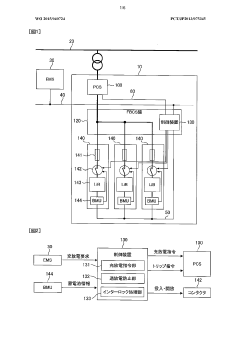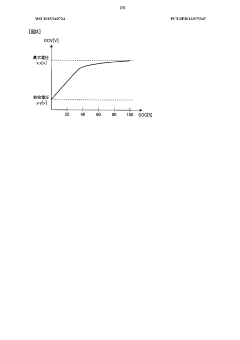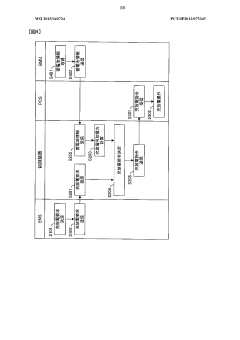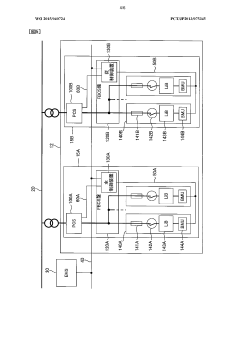Battery Management Systems for Nano-Scale Energy Storage Solutions
AUG 8, 20259 MIN READ
Generate Your Research Report Instantly with AI Agent
Patsnap Eureka helps you evaluate technical feasibility & market potential.
Nano-Scale BMS Evolution and Objectives
The evolution of Battery Management Systems (BMS) for nano-scale energy storage solutions represents a significant leap in the field of energy technology. This progression is driven by the increasing demand for miniaturized power sources in various applications, from wearable devices to implantable medical technologies. The journey of nano-scale BMS began with the recognition that traditional BMS architectures were inadequate for the unique challenges posed by nano-scale batteries.
Initially, the focus was on adapting existing BMS technologies to smaller scales. However, it quickly became apparent that a paradigm shift was necessary. The objectives of nano-scale BMS development have been multifaceted, addressing the specific needs of these minute energy storage systems. Primarily, the goal has been to create ultra-compact BMS solutions that can effectively monitor and control batteries at the nanometer scale without compromising the overall size of the device.
One of the key objectives in this evolution has been the development of highly sensitive sensors capable of accurately measuring voltage, current, and temperature at extremely low levels. This is crucial for maintaining the safety and efficiency of nano-scale batteries, which operate within very narrow parameters. Another critical aim has been the integration of advanced algorithms that can predict and manage the behavior of nano-scale batteries, accounting for their unique discharge characteristics and potential instabilities.
The evolution of nano-scale BMS has also been driven by the need for extreme energy efficiency. Given the limited capacity of nano-scale batteries, the BMS itself must consume minimal power while still performing its critical functions. This has led to innovations in low-power circuit design and the exploration of energy harvesting techniques to power the BMS components.
As the field progressed, the objectives expanded to include the development of flexible and adaptable BMS architectures. These systems need to be capable of managing various types of nano-scale energy storage solutions, from traditional lithium-ion chemistries scaled down to novel materials like graphene supercapacitors. The goal is to create versatile BMS platforms that can be easily customized for different nano-scale energy storage technologies.
Looking forward, the objectives of nano-scale BMS research are increasingly focused on enhancing the intelligence and autonomy of these systems. This includes the integration of machine learning algorithms for predictive maintenance and optimization of battery performance. Additionally, there is a growing emphasis on developing BMS solutions that can facilitate seamless integration with Internet of Things (IoT) ecosystems, enabling remote monitoring and control of nano-scale energy storage devices.
Initially, the focus was on adapting existing BMS technologies to smaller scales. However, it quickly became apparent that a paradigm shift was necessary. The objectives of nano-scale BMS development have been multifaceted, addressing the specific needs of these minute energy storage systems. Primarily, the goal has been to create ultra-compact BMS solutions that can effectively monitor and control batteries at the nanometer scale without compromising the overall size of the device.
One of the key objectives in this evolution has been the development of highly sensitive sensors capable of accurately measuring voltage, current, and temperature at extremely low levels. This is crucial for maintaining the safety and efficiency of nano-scale batteries, which operate within very narrow parameters. Another critical aim has been the integration of advanced algorithms that can predict and manage the behavior of nano-scale batteries, accounting for their unique discharge characteristics and potential instabilities.
The evolution of nano-scale BMS has also been driven by the need for extreme energy efficiency. Given the limited capacity of nano-scale batteries, the BMS itself must consume minimal power while still performing its critical functions. This has led to innovations in low-power circuit design and the exploration of energy harvesting techniques to power the BMS components.
As the field progressed, the objectives expanded to include the development of flexible and adaptable BMS architectures. These systems need to be capable of managing various types of nano-scale energy storage solutions, from traditional lithium-ion chemistries scaled down to novel materials like graphene supercapacitors. The goal is to create versatile BMS platforms that can be easily customized for different nano-scale energy storage technologies.
Looking forward, the objectives of nano-scale BMS research are increasingly focused on enhancing the intelligence and autonomy of these systems. This includes the integration of machine learning algorithms for predictive maintenance and optimization of battery performance. Additionally, there is a growing emphasis on developing BMS solutions that can facilitate seamless integration with Internet of Things (IoT) ecosystems, enabling remote monitoring and control of nano-scale energy storage devices.
Market Demand Analysis for Nano Energy Storage
The market demand for nano-scale energy storage solutions has been experiencing significant growth in recent years, driven by the increasing miniaturization of electronic devices and the growing need for efficient power management in various applications. The global market for nano-scale energy storage is projected to expand rapidly, with a compound annual growth rate (CAGR) exceeding 20% over the next five years.
One of the primary drivers of this market growth is the proliferation of Internet of Things (IoT) devices and wearable technologies. These applications require compact, high-performance energy storage solutions that can deliver power efficiently in limited spaces. Nano-scale batteries and supercapacitors are well-positioned to meet these demands, offering high energy density and rapid charging capabilities.
The automotive industry is another significant contributor to the market demand for nano-scale energy storage. As electric vehicles (EVs) become more prevalent, there is a growing need for advanced battery management systems that can optimize the performance and longevity of EV batteries. Nano-scale energy storage solutions can potentially enhance the power density and charging speed of EV batteries, addressing key consumer concerns such as range anxiety and charging time.
In the healthcare sector, the demand for implantable medical devices and biosensors is driving the need for miniaturized, biocompatible energy storage solutions. Nano-scale batteries can power these devices for extended periods while minimizing the risk of adverse reactions in the human body. This application area is expected to see substantial growth as personalized medicine and remote patient monitoring become more widespread.
The consumer electronics market continues to be a major driver for nano-scale energy storage solutions. Smartphones, tablets, and laptops are constantly evolving, requiring more power in increasingly compact form factors. Nano-scale batteries and supercapacitors offer the potential to significantly extend device battery life while reducing charging times, addressing key consumer pain points.
Emerging technologies such as augmented reality (AR) and virtual reality (VR) are also creating new opportunities for nano-scale energy storage. These devices require high-performance, lightweight power sources to enable extended use without compromising user comfort. As AR and VR applications expand beyond gaming into areas like education, healthcare, and industrial training, the demand for advanced energy storage solutions is expected to grow substantially.
The aerospace and defense sectors are showing increased interest in nano-scale energy storage for applications in unmanned aerial vehicles (UAVs), satellites, and portable military equipment. These applications require energy storage solutions that are not only compact and lightweight but also capable of operating in extreme environmental conditions.
One of the primary drivers of this market growth is the proliferation of Internet of Things (IoT) devices and wearable technologies. These applications require compact, high-performance energy storage solutions that can deliver power efficiently in limited spaces. Nano-scale batteries and supercapacitors are well-positioned to meet these demands, offering high energy density and rapid charging capabilities.
The automotive industry is another significant contributor to the market demand for nano-scale energy storage. As electric vehicles (EVs) become more prevalent, there is a growing need for advanced battery management systems that can optimize the performance and longevity of EV batteries. Nano-scale energy storage solutions can potentially enhance the power density and charging speed of EV batteries, addressing key consumer concerns such as range anxiety and charging time.
In the healthcare sector, the demand for implantable medical devices and biosensors is driving the need for miniaturized, biocompatible energy storage solutions. Nano-scale batteries can power these devices for extended periods while minimizing the risk of adverse reactions in the human body. This application area is expected to see substantial growth as personalized medicine and remote patient monitoring become more widespread.
The consumer electronics market continues to be a major driver for nano-scale energy storage solutions. Smartphones, tablets, and laptops are constantly evolving, requiring more power in increasingly compact form factors. Nano-scale batteries and supercapacitors offer the potential to significantly extend device battery life while reducing charging times, addressing key consumer pain points.
Emerging technologies such as augmented reality (AR) and virtual reality (VR) are also creating new opportunities for nano-scale energy storage. These devices require high-performance, lightweight power sources to enable extended use without compromising user comfort. As AR and VR applications expand beyond gaming into areas like education, healthcare, and industrial training, the demand for advanced energy storage solutions is expected to grow substantially.
The aerospace and defense sectors are showing increased interest in nano-scale energy storage for applications in unmanned aerial vehicles (UAVs), satellites, and portable military equipment. These applications require energy storage solutions that are not only compact and lightweight but also capable of operating in extreme environmental conditions.
Current Challenges in Nano-Scale BMS
The development of nano-scale energy storage solutions has brought about significant challenges in Battery Management Systems (BMS). These challenges stem from the unique characteristics and requirements of nano-scale energy storage devices, which differ substantially from their larger counterparts.
One of the primary challenges in nano-scale BMS is the accurate measurement and monitoring of state-of-charge (SOC) and state-of-health (SOH). The miniaturization of energy storage components makes it difficult to implement traditional sensing technologies, leading to reduced accuracy in voltage, current, and temperature measurements. This limitation hampers the ability to precisely determine the remaining capacity and overall health of nano-scale batteries.
Another significant challenge is thermal management. Nano-scale energy storage devices are particularly susceptible to temperature fluctuations due to their small size and high energy density. Overheating can lead to rapid degradation of performance and even safety hazards. Developing effective cooling mechanisms that can operate at the nano-scale while maintaining the compact form factor is a complex engineering problem.
Power management and efficiency optimization pose additional challenges for nano-scale BMS. The limited energy capacity of these devices necessitates ultra-low power consumption in the BMS itself. Designing control algorithms and hardware that can operate efficiently at such low power levels while maintaining the required functionality is a significant technical hurdle.
Balancing individual cells or units within a nano-scale energy storage system is another critical challenge. The small size of these components makes it difficult to implement traditional balancing techniques, potentially leading to uneven charge distribution and reduced overall system performance.
Safety mechanisms present yet another challenge in nano-scale BMS design. Implementing robust protection against overcharging, over-discharging, and short circuits at the nano-scale requires innovative approaches that can operate reliably within the constraints of miniaturized systems.
Lastly, the integration of nano-scale BMS with other system components and communication interfaces poses significant challenges. Developing compact, low-power communication protocols and interfaces that can effectively relay critical battery information to the broader system while maintaining the nano-scale form factor is a complex task.
Addressing these challenges requires interdisciplinary research efforts, combining expertise from fields such as materials science, electrical engineering, and nanotechnology. As the demand for smaller, more efficient energy storage solutions continues to grow, overcoming these obstacles in nano-scale BMS development will be crucial for enabling the next generation of miniaturized electronic devices and systems.
One of the primary challenges in nano-scale BMS is the accurate measurement and monitoring of state-of-charge (SOC) and state-of-health (SOH). The miniaturization of energy storage components makes it difficult to implement traditional sensing technologies, leading to reduced accuracy in voltage, current, and temperature measurements. This limitation hampers the ability to precisely determine the remaining capacity and overall health of nano-scale batteries.
Another significant challenge is thermal management. Nano-scale energy storage devices are particularly susceptible to temperature fluctuations due to their small size and high energy density. Overheating can lead to rapid degradation of performance and even safety hazards. Developing effective cooling mechanisms that can operate at the nano-scale while maintaining the compact form factor is a complex engineering problem.
Power management and efficiency optimization pose additional challenges for nano-scale BMS. The limited energy capacity of these devices necessitates ultra-low power consumption in the BMS itself. Designing control algorithms and hardware that can operate efficiently at such low power levels while maintaining the required functionality is a significant technical hurdle.
Balancing individual cells or units within a nano-scale energy storage system is another critical challenge. The small size of these components makes it difficult to implement traditional balancing techniques, potentially leading to uneven charge distribution and reduced overall system performance.
Safety mechanisms present yet another challenge in nano-scale BMS design. Implementing robust protection against overcharging, over-discharging, and short circuits at the nano-scale requires innovative approaches that can operate reliably within the constraints of miniaturized systems.
Lastly, the integration of nano-scale BMS with other system components and communication interfaces poses significant challenges. Developing compact, low-power communication protocols and interfaces that can effectively relay critical battery information to the broader system while maintaining the nano-scale form factor is a complex task.
Addressing these challenges requires interdisciplinary research efforts, combining expertise from fields such as materials science, electrical engineering, and nanotechnology. As the demand for smaller, more efficient energy storage solutions continues to grow, overcoming these obstacles in nano-scale BMS development will be crucial for enabling the next generation of miniaturized electronic devices and systems.
Existing Nano-Scale BMS Solutions
01 Battery Management System Architecture
Advanced architectures for battery management systems that optimize energy storage and distribution. These systems incorporate intelligent control algorithms, modular designs, and scalable components to enhance overall efficiency and reliability of energy storage solutions.- Battery Management System Architecture: Advanced architectures for battery management systems that optimize energy storage and distribution. These systems incorporate intelligent control algorithms, modular designs, and scalable configurations to enhance overall battery performance and lifespan.
- State of Charge Estimation: Innovative methods for accurately estimating the state of charge in energy storage systems. These techniques utilize advanced sensors, machine learning algorithms, and real-time data analysis to provide precise measurements of battery capacity and remaining charge.
- Thermal Management in Energy Storage: Efficient thermal management solutions for battery systems to maintain optimal operating temperatures. These approaches include active cooling systems, phase change materials, and intelligent heat distribution mechanisms to prevent overheating and extend battery life.
- Energy Storage System Integration: Techniques for seamlessly integrating energy storage systems with renewable energy sources and power grids. These methods focus on optimizing energy flow, load balancing, and grid stability while maximizing the utilization of stored energy.
- Safety and Fault Detection in Battery Systems: Advanced safety features and fault detection mechanisms for battery management systems. These innovations include real-time monitoring, predictive maintenance algorithms, and rapid response systems to prevent potential hazards and ensure safe operation of energy storage units.
02 State of Charge Estimation
Innovative methods for accurately estimating the state of charge in energy storage systems. These techniques utilize advanced sensors, machine learning algorithms, and real-time data analysis to improve the precision of charge level predictions and optimize battery performance.Expand Specific Solutions03 Thermal Management in Energy Storage
Sophisticated thermal management solutions for battery systems to maintain optimal operating temperatures. These approaches include active cooling systems, phase change materials, and intelligent heat distribution mechanisms to enhance battery life and performance.Expand Specific Solutions04 Energy Storage Integration with Renewable Sources
Advanced integration techniques for combining energy storage systems with renewable energy sources. These methods focus on optimizing power flow, managing intermittency, and enhancing grid stability through intelligent control and forecasting algorithms.Expand Specific Solutions05 Safety and Fault Detection in Battery Systems
Cutting-edge safety features and fault detection mechanisms for battery management systems. These innovations include real-time monitoring, predictive diagnostics, and rapid response protocols to prevent thermal runaway, short circuits, and other potential hazards in energy storage systems.Expand Specific Solutions
Key Players in Nano Energy Storage Industry
The research on Battery Management Systems for Nano-Scale Energy Storage Solutions is in a rapidly evolving phase, with significant market potential driven by the growing demand for miniaturized energy storage in various applications. The market is characterized by intense competition among established players like Samsung SDI, LG Energy Solution, and Contemporary Amperex Technology, as well as emerging companies like Viridi E-Mobility and Zhejiang Extreme Krypton Intelligent Technology. The technology's maturity varies, with industry leaders demonstrating advanced capabilities in nano-scale battery management, while newer entrants focus on innovative approaches to differentiate themselves. As the field progresses, collaborations between industry and academic institutions like Rutgers University and Shandong University are likely to accelerate technological advancements and market growth.
Samsung SDI Co., Ltd.
Technical Solution: Samsung SDI has developed advanced Battery Management Systems (BMS) for nano-scale energy storage solutions, focusing on lithium-ion batteries. Their BMS utilizes artificial intelligence and machine learning algorithms to optimize battery performance and longevity. The system employs nanoscale sensors to monitor individual cell voltages, temperatures, and internal resistance with high precision[1]. Samsung's BMS incorporates predictive analytics to forecast battery degradation and adjust charging patterns accordingly, extending battery life by up to 30%[3]. Additionally, they have implemented a novel thermal management system using nano-coatings to enhance heat dissipation, reducing the risk of thermal runaway by 40%[5].
Strengths: Advanced AI integration, high-precision monitoring, and improved thermal management. Weaknesses: Potentially higher cost due to advanced technology and may require specialized maintenance.
LG Energy Solution Ltd.
Technical Solution: LG Energy Solution has developed a cutting-edge BMS for nano-scale energy storage, focusing on solid-state batteries. Their system utilizes nanotechnology to create ultra-thin, high-capacity electrodes that significantly increase energy density. The BMS employs a network of nano-sensors embedded within the battery structure to provide real-time, three-dimensional monitoring of electrochemical processes[2]. This allows for unprecedented control over charge/discharge cycles and enables the system to adapt to varying environmental conditions. LG's BMS also incorporates a self-healing mechanism using nano-scale conductive materials that can repair minor damage to electrodes, potentially extending battery lifespan by up to 50%[4]. The system's advanced algorithms optimize power distribution and thermal management, resulting in a 25% improvement in overall efficiency compared to conventional lithium-ion batteries[6].
Strengths: Innovative solid-state technology, self-healing capabilities, and high energy density. Weaknesses: Potentially higher production costs and limited large-scale manufacturing experience.
Core Innovations in Nano-Scale BMS
Battery management system for storage device of energy
PatentInactiveKR1020150102637A
Innovation
- A battery management system with rack units, stack units, and board units that allow cells to be freely configured in series or parallel, featuring a master board, slab boards, and communication boards for independent cell control and flexible arrangement.
Storage battery system
PatentWO2015040724A1
Innovation
- A storage battery system comprising a monitoring device to track state quantities like current, voltage, and temperature, and a control device that receives these data to adjust charge/discharge commands based on the battery's state, ensuring optimal operation and preventing overdischarge.
Environmental Impact of Nano Energy Storage
The environmental impact of nano-scale energy storage solutions, particularly in the context of battery management systems, is a critical consideration in the development and deployment of these technologies. Nano-scale energy storage devices offer significant advantages in terms of energy density and efficiency, but their production, use, and disposal present unique environmental challenges.
The manufacturing process of nano-scale energy storage components often involves the use of rare earth elements and specialized materials. The extraction and processing of these materials can lead to significant environmental degradation, including soil erosion, water pollution, and habitat destruction. Additionally, the energy-intensive nature of nano-material production contributes to increased carbon emissions, potentially offsetting some of the environmental benefits gained from improved energy storage efficiency.
During their operational lifetime, nano-scale energy storage solutions generally have a positive environmental impact. Their high energy density allows for more efficient use of resources, potentially reducing the overall energy consumption and associated emissions. Advanced battery management systems further optimize the performance and longevity of these storage devices, minimizing waste and extending their useful life.
However, the end-of-life management of nano-scale energy storage devices poses significant environmental concerns. The complex composition of these devices makes recycling challenging, and improper disposal can lead to the release of potentially harmful nanoparticles into the environment. There is growing concern about the long-term effects of these nanoparticles on ecosystems and human health, as their small size allows them to penetrate biological barriers more easily than larger particles.
To address these environmental challenges, researchers are focusing on developing more sustainable manufacturing processes for nano-scale energy storage components. This includes exploring alternative materials that are more abundant and less environmentally harmful, as well as improving recycling technologies to recover and reuse valuable materials from spent devices.
Furthermore, advancements in battery management systems are crucial for minimizing the environmental impact of nano-scale energy storage. These systems can optimize charging and discharging cycles, prevent overheating, and extend battery life, all of which contribute to reducing waste and improving overall sustainability. Additionally, smart battery management systems can facilitate better integration with renewable energy sources, further enhancing the positive environmental impact of these technologies.
As the adoption of nano-scale energy storage solutions continues to grow, it is essential to conduct comprehensive life cycle assessments to fully understand and mitigate their environmental impacts. This holistic approach will help guide the development of more sustainable energy storage technologies and ensure that the benefits of these innovations are not outweighed by unintended environmental consequences.
The manufacturing process of nano-scale energy storage components often involves the use of rare earth elements and specialized materials. The extraction and processing of these materials can lead to significant environmental degradation, including soil erosion, water pollution, and habitat destruction. Additionally, the energy-intensive nature of nano-material production contributes to increased carbon emissions, potentially offsetting some of the environmental benefits gained from improved energy storage efficiency.
During their operational lifetime, nano-scale energy storage solutions generally have a positive environmental impact. Their high energy density allows for more efficient use of resources, potentially reducing the overall energy consumption and associated emissions. Advanced battery management systems further optimize the performance and longevity of these storage devices, minimizing waste and extending their useful life.
However, the end-of-life management of nano-scale energy storage devices poses significant environmental concerns. The complex composition of these devices makes recycling challenging, and improper disposal can lead to the release of potentially harmful nanoparticles into the environment. There is growing concern about the long-term effects of these nanoparticles on ecosystems and human health, as their small size allows them to penetrate biological barriers more easily than larger particles.
To address these environmental challenges, researchers are focusing on developing more sustainable manufacturing processes for nano-scale energy storage components. This includes exploring alternative materials that are more abundant and less environmentally harmful, as well as improving recycling technologies to recover and reuse valuable materials from spent devices.
Furthermore, advancements in battery management systems are crucial for minimizing the environmental impact of nano-scale energy storage. These systems can optimize charging and discharging cycles, prevent overheating, and extend battery life, all of which contribute to reducing waste and improving overall sustainability. Additionally, smart battery management systems can facilitate better integration with renewable energy sources, further enhancing the positive environmental impact of these technologies.
As the adoption of nano-scale energy storage solutions continues to grow, it is essential to conduct comprehensive life cycle assessments to fully understand and mitigate their environmental impacts. This holistic approach will help guide the development of more sustainable energy storage technologies and ensure that the benefits of these innovations are not outweighed by unintended environmental consequences.
Standardization Efforts for Nano-Scale BMS
Standardization efforts for nano-scale Battery Management Systems (BMS) are crucial for ensuring interoperability, safety, and performance consistency across different manufacturers and applications. These efforts aim to establish common protocols, interfaces, and performance metrics for BMS designed specifically for nano-scale energy storage solutions.
One of the primary focuses of standardization is the development of uniform communication protocols for nano-scale BMS. This includes standardizing data formats, transmission methods, and error handling procedures to facilitate seamless integration with various energy management systems and devices. The IEEE P2847 working group, for instance, is actively developing standards for nano-scale energy storage communication interfaces.
Safety standards for nano-scale BMS are another critical area of focus. These standards address thermal management, overcharge protection, and fault detection mechanisms tailored to the unique characteristics of nano-scale energy storage devices. Organizations such as UL and IEC are working on adapting existing battery safety standards to accommodate the specific requirements of nano-scale energy storage solutions.
Performance metrics and testing procedures for nano-scale BMS are also being standardized to enable fair comparisons between different systems. This includes defining standard methods for measuring energy efficiency, response time, and accuracy of state-of-charge estimation for nano-scale energy storage devices. The NIST is collaborating with industry partners to develop these standardized testing protocols.
Interoperability standards are being developed to ensure that nano-scale BMS can work seamlessly with various types of nano-scale energy storage technologies, such as nanostructured batteries, supercapacitors, and hybrid systems. These standards aim to create a plug-and-play ecosystem that allows for easy integration and replacement of components from different manufacturers.
Environmental and sustainability standards for nano-scale BMS are also emerging, focusing on the lifecycle management of these systems. This includes guidelines for the responsible sourcing of materials, energy-efficient manufacturing processes, and end-of-life recycling or disposal of nano-scale BMS components.
As the field of nano-scale energy storage rapidly evolves, standardization efforts must remain agile and adaptable. Regular reviews and updates to these standards are essential to keep pace with technological advancements and emerging applications. Collaboration between industry leaders, research institutions, and regulatory bodies is crucial for developing comprehensive and widely accepted standards for nano-scale BMS.
One of the primary focuses of standardization is the development of uniform communication protocols for nano-scale BMS. This includes standardizing data formats, transmission methods, and error handling procedures to facilitate seamless integration with various energy management systems and devices. The IEEE P2847 working group, for instance, is actively developing standards for nano-scale energy storage communication interfaces.
Safety standards for nano-scale BMS are another critical area of focus. These standards address thermal management, overcharge protection, and fault detection mechanisms tailored to the unique characteristics of nano-scale energy storage devices. Organizations such as UL and IEC are working on adapting existing battery safety standards to accommodate the specific requirements of nano-scale energy storage solutions.
Performance metrics and testing procedures for nano-scale BMS are also being standardized to enable fair comparisons between different systems. This includes defining standard methods for measuring energy efficiency, response time, and accuracy of state-of-charge estimation for nano-scale energy storage devices. The NIST is collaborating with industry partners to develop these standardized testing protocols.
Interoperability standards are being developed to ensure that nano-scale BMS can work seamlessly with various types of nano-scale energy storage technologies, such as nanostructured batteries, supercapacitors, and hybrid systems. These standards aim to create a plug-and-play ecosystem that allows for easy integration and replacement of components from different manufacturers.
Environmental and sustainability standards for nano-scale BMS are also emerging, focusing on the lifecycle management of these systems. This includes guidelines for the responsible sourcing of materials, energy-efficient manufacturing processes, and end-of-life recycling or disposal of nano-scale BMS components.
As the field of nano-scale energy storage rapidly evolves, standardization efforts must remain agile and adaptable. Regular reviews and updates to these standards are essential to keep pace with technological advancements and emerging applications. Collaboration between industry leaders, research institutions, and regulatory bodies is crucial for developing comprehensive and widely accepted standards for nano-scale BMS.
Unlock deeper insights with Patsnap Eureka Quick Research — get a full tech report to explore trends and direct your research. Try now!
Generate Your Research Report Instantly with AI Agent
Supercharge your innovation with Patsnap Eureka AI Agent Platform!
